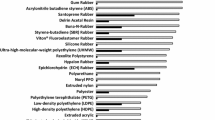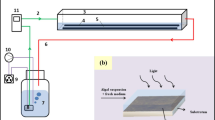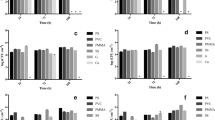Abstract
Adhesion of Chlorella vulgaris(chlorophyceae), Nitzschia amphibia(bacillariophceae) and Chroococcus minutus(cyanobacteria) to hydrophobic (perspex, titanium and stainless steel 316-L), hydrophilic (glass) and toxic (copper, aluminium brass and admiralty brass) substrata were studied in the laboratory. The influence of surface wettability, surface roughness, pH of the medium, culture age, culture density, cell viability and presence of organic and bacterial films on the adhesion of Nitzschia amphibia was also studied using titanium, stainless steel and glass surfaces. All three organisms attached more on titanium and stainless steel and less on copper and its alloys. The attachment varied significantly with respect to exposure time and different materials. The attachment was higher on rough surfaces when compared to smooth surfaces. Attachment was higher on pH 7 and above. The presence of organic film increased the attachment significantly when compared to control. The number of attached cells was found to be directly proportional to the culture density. Attachment by log phase cells was significantly higher when compared to stationary phase cells. Live cells attached more when compared to heat killed and formalin killed cells. Bacterial films of Pseudomonas putida increased the algal attachment significantly. %
Similar content being viewed by others
References
Becker, K., 1996. Exopolysaccharide production and attachment strength of bacteria and diatoms on substrates with different surface tensions. Microb. Ecol. 32: 23–33.
Becker, K. & M. Wahl, 1991. Influence of substratum surface tension on biofouling of artificial substrata in Kiel Bay (Western Baltic): in situ studies. Biofouling 4: 275–291.
Bott, T. R., 1990. Fouling Notebook. Institution of Chemical Engineers, England.
Burchard, R. P., D. Rittschof & J. Bonaventura, 1990. Adhesion and motility of gliding bacteria on substrata with different surface free energy. Appl. envir. Microbiol. 56: 2529–2534.
Callow, M. E., 1993. A review of fouling in freshwaters. Biofouling 7: 313–327.
Characklis, W. G. & K. E. Cooksey, 1983. Biofilms and microbial fouling. Adv. Appl. Microbiol. 29: 93–138.
Characklis, W. G., C. A. McFeters & K. C. Marshall, 1990. Physiological ecology in biofilm systems. In Characklis W. G. & K. C. Marshall (eds), Biofilms. John Wiley & Sons, Inc., New York: 341–394.
Droop, M.R., 1967. A procedure for routine purification of algal cultures with antibiotics. Br. Phycol. Bull. 3: 295–297.
Fattom, A. & M. Shilo, 1984. Hydrophobicity as an adhesion mechanism of benthic cyanobacteria. Appl. envir. Microbiol. 47: 135–143.
Ford, T. E., M. Walch, R. Mitchell, M. J. Kaufman, J. R. Vestal, S. A. Ditner & M. A. Lock, 1989. Microbial film formation on metals in an enriched arctic river. Biofouling 1: 301–311.
Fukami, K., T. Sakami, Y. Ishida & N. Tanaka, 1989. Effect of bacterial film on the growth of the attached diatom, Nitzschia sp. In Miyachi, S., I. Karube & Y. Isida (eds), Current Topics in Marine Biotechnology. The Japanese Society for Marine Biotechnology, Tokyo: 415–418.
Gerloff, G. C., G. P. Fitzerald & F. Skoog, 1950. The isolation, purification and culture of blue-green algae. Am. J. Bot. 37: 216–218.
Hoagland, K. D., J. R. Rosowski, M. R., Gretz & S. C. Roemer, 1993. Diatom extracellular polymeric substances: function, fine structure, chemistry and physiology. J. Phycol. 29: 537–566.
Holmes, P. E., 1986. Bacterial enhancement of vinyl fouling by algae. Appl. envir. Microbiol. 52: 1391–1393.
Hunt, A. & J. D. Parry, 1998. The effect of substratum roughness and river flow rate on the development of freshwater biofilm community. Biofouling 12: 287–303.
Kawamura, T., Y. Nimura & R. Hirano, 1988. Effects of bacterial films on diatom attachment in the initial phase of marine fouling. J. Oceanogr. Soc. Jap. 44: 1–5.
Keithan, E. & L. Barnese, 1989. Effects of pH and nutrients on periphyton colonization. J. Phycol. 25 suppl: 8.
Kirchman, D., S. Graham, D. Reish & R. Mitchell, 1982. Bacterial induce settlement and metamorphosis of Janua (Dexiospira) brasiliensis Grube (Polychaeta: Spiroribidae). J. exp. mar. Biol. Ecol., 56: 153–163.
Liehr, S. K., J. W. Eheart & M. T. Suidan, 1988. A modelling study of the effect of pH on carbon limited algal biofilms. Wat. Res. 22: 1033–1041.
Ludyansky, M. L., 1991. Algal fouling in the cooling system. Biofouling 3: 13–21.
Peterson, C. G. & R. J. Stevenson, 1989. Substratum conditioning and diatom colonization in different current regimes. J. Phycol. 25: 790–793.
Rao, T. S., M. S. Eswaran, V. P. Venugopalan, K. V. K. Nair & P. K. Mathur, 1993. Fouling and corrosion in an open recirculating cooling system. Biofouling 6: 245–259.
Scott, C., R. L. Fletcher & G. B. Bremer, 1996. Observations on the mechanisms of attachment of some marine fouling blue-green algae. Biofouling 10: 161–173.
Sharma, M. O., N. B. Bhosle & A. B. Wagh, 1990. Method of removal and estimation of microfouling biomass. Indian J. mar. Sci. 19: 174–176.
Sokal, R. R. & J. Rohlf, 1987. Introduction to Biostatistics. 2nd edn. W.H. Freeman & Company, New York.
Steinman, A. D. & A. F. Parker, 1990. Influence of substrate conditioning on periphytic growth in a heterotrophic woodland stream. J. N. Am. Benthol. Soc. 9: 170–179.
Tosteson, T. R. & W. A. Corpe, 1975. Enhancement of adhesion of the marine Chlorella vulgaris to glass. Can. J. Microbiol. 21: 1025–1031.
Woods, D. C. & R. L. Fletcher, 1991. Studies on the strength of adhesion of some common marine fouling diatoms. Biofouling 3: 287–303.
Wrangstadeth, M., P. L. Conway & S. Kjellberg, 1996. The release and production of extracellular polysaccharides during starvation of marine Pseudomonas sp. and the effect thereof on the adhesion. Arch. Microbiol. 145: 220–227.
Zaidi, B. R. & T. R. Tosteson, 1972. The differential adhesion of Chlorella cells during the life cycle. Proc. Int. Seaweed Symp. 7: 323–328.
Author information
Authors and Affiliations
Rights and permissions
About this article
Cite this article
Sekar, R., Venugopalan, V., Satpathy, K. et al. Laboratory studies on adhesion of microalgae to hard substrates. Hydrobiologia 512, 109–116 (2004). https://doi.org/10.1023/B:HYDR.0000020315.40349.38
Issue Date:
DOI: https://doi.org/10.1023/B:HYDR.0000020315.40349.38




